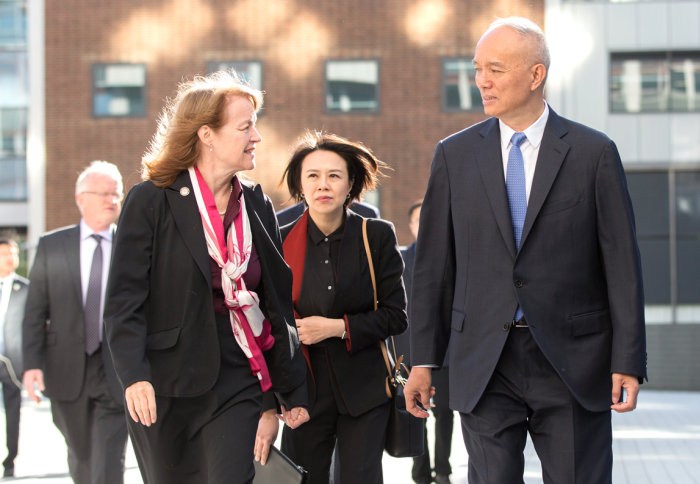Beijing leader hails growing Imperial-China collaborations

One of China’s top officials visited Imperial College London to explore research into sustainable transport and air quality control.
Mr Cai Qi, Secretary of the CPC Municipal Committee for Beijing, visited on Monday (14 May) and saw some of the ways Imperial has become the UK’s number one academic research partner with China, and the potential for future collaborations.
Mr Cai works closely with Chen Jining, an Imperial alumnus who serves as Mayor of Beijing, as well as China’s President Xi Jinping who visited Imperial in 2015.

One of their top priorities is to reduce smog and air pollution in the Chinese capital while continuing to develop smart infrastructure for the city’s 21 million residents.
Mr Cai was accompanied by China’s Ambassador to the United Kingdom Liu Xiaoming and were welcomed by Imperial’s President Alice Gast and Provost James Stirling.
Top academic partners

President Gast told Mr Cai how Imperial is the UK's top university collaborator with China and has more than 2,500 Chinese students.
President Gast said: "Imperial is collaborating with Chinese universities and corporations in areas such as the environment, sustainability, infrastructure, clean coal and climate change.
“Imperial is developing a strategic partnership with Tsinghua University and 45 of our students will visit Beijing this summer as part of a joint education programme.
“Beijing and London have a lot in common and we are eager to collaborate with the Beijing government to enhance the city as a political centre, cultural centre, centre for international exchanges, and centre for scientific and technological innovation."
Inspirational research

Mr Cai and the delegation visited Imperial’s Global Data Observatory within the Data Science Institute to see research presentations by leading academics on big data, air quality and transport infrastructure.
Mr Cai, who sent regards from Chen Jining, the Mayor of Beijing who completed a PhD in Civil and Environmental Engineering at Imperial in 1992, said ‘the visit makes us feel closer to Imperial College.’
Commenting on the research projects, Mr Cai said: “You have tried to provide solutions to troubles and challenges, which is very inspirational.
“Beijing is facing many challenges which London has faced in the past, for example transport congestion and air quality.
“Beijing understands the importance of applications of big data and we’re establishing a centre for this.
“It is even more important to use big data in city management. We need to step up our collaboration with the Data Science Institute.”
Global network of collaborators

Professor Yi-ke Guo, Director of the Data Science Institute, used the Data Observatory to show visualisations of movement through Chinese Metro stations and real-time cryptocurrency transactions.
Professor Washington Ochieng, Head of the Centre for Transport Studies, presented an overview of the Centre’s research areas.

Professor Ochieng said: “We work across the entire chain of transport infrastructure, and in research we aim to be the best in the world.
“We want to maximise the benefits of transport but not at the expense of the environment, safety and security.”
Professor Ochieng, highlighted how the International Benchmarking Group are working with Beijing Subway to improve transport efficiency.
The Centre has a global network of collaborators including Tsinghua University and Beijing Jiaotong University.
Transport efficiency

Dr Marc Stettler, Director of the Transport & Environment Laboratory, spoke about his research into developing tools and technology to enhance transport efficiency and reduce its impact on the environment.
His group are supporting technology used in Formula 1, which can harvest energy from braking, and implement it into freight vehicles.
Dr Stettler is also using transport mapping activity to monitor vehicle emissions.
Dr Stettler said: “We are exploring the effects of different driving styles on transport emissions, using high resolution mapping.
“We are finding that emissions are concentrated around intersections and traffic lights, where people are likely to be crossing the road.
“Through a mobile app, drivers can be supported to drive more smoothly to reduce emissions.”
Article text (excluding photos or graphics) © Imperial College London.
Photos and graphics subject to third party copyright used with permission or © Imperial College London.
Reporter
Stephen Johns
Communications Division
Thomas Angus [Photographer]
Communications Division
Andrew Scheuber
Communications Division